How to Manage Cat Introductions to Outdoor Wildlife
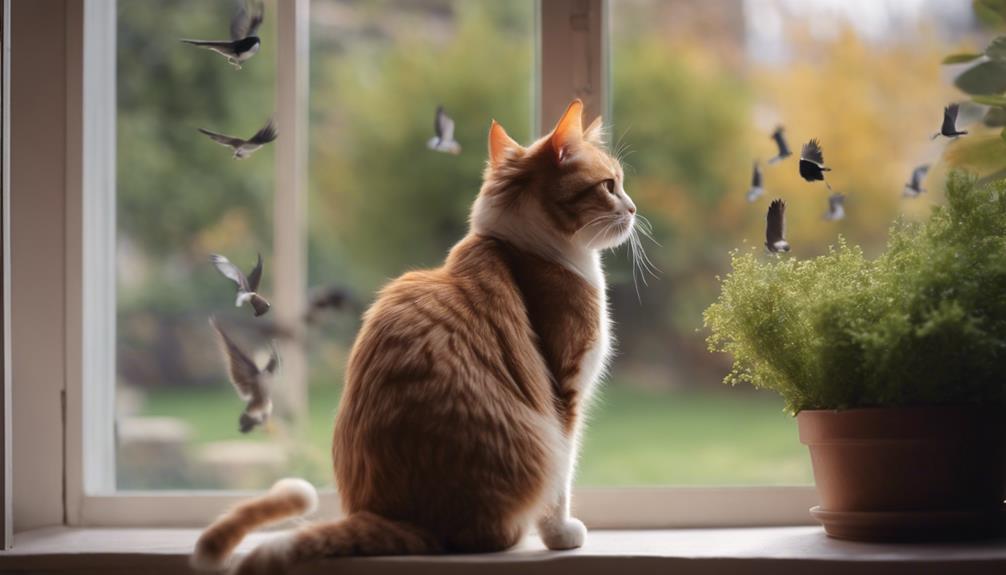
Tips for managing cat introductions to outdoor wildlife include: providing a secure outdoor enclosure for your cat, supervising outdoor time, using deterrents like bells on collars, and creating a safe outdoor space for wildlife. It is essential to balance the needs of your pet with the well-being of local wildlife populations. With proper management and awareness, it is possible to create a harmonious coexistence between cats and outdoor wildlife.
Understanding Cat Behavior Outdoors
When exploring the outdoors, cats exhibit a range of behaviors that are essential to understand for their well-being and the safety of wildlife. Cat hunting instincts are deeply ingrained in their nature, stemming from their ancestry as hunters. This instinct drives them to stalk, chase, and pounce on prey, even if they're well-fed pets. Understanding this aspect of their behavior is crucial when allowing them outside, as they may view smaller animals as prey.
Moreover, outdoor territory dynamics play a significant role in how cats behave. Cats are territorial animals, marking their outdoor spaces with scent glands on their cheeks, paws, and tails. This marking behavior not only helps them establish boundaries but also communicate with other cats. When introducing a cat to outdoor wildlife, being aware of their territorial instincts can help prevent conflicts with other animals in the area.
Identifying Potential Wildlife Encounters
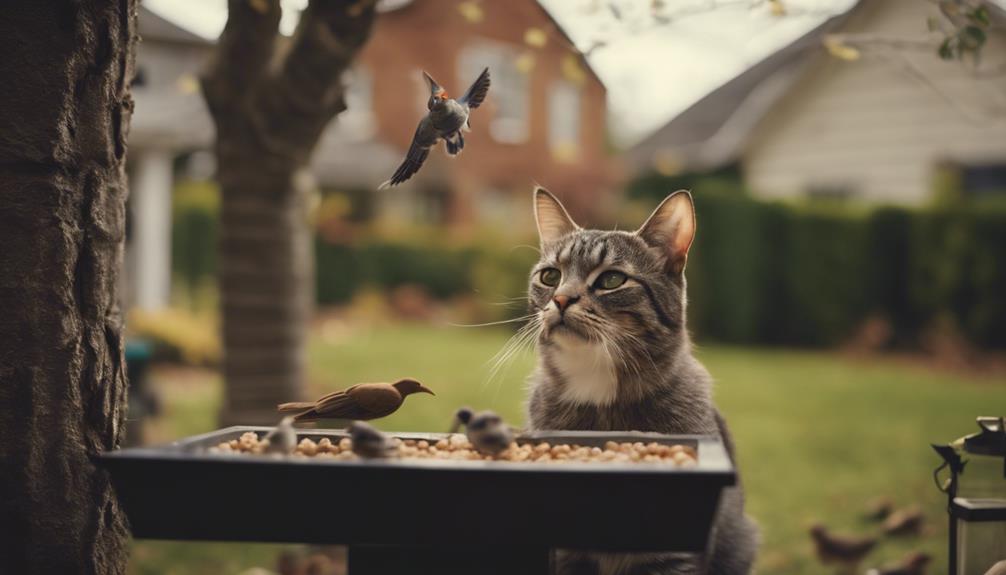
Cats' outdoor exploration often leads to encounters with various wildlife species, necessitating an understanding of potential interactions for their safety and the well-being of local fauna.
When identifying potential wildlife encounters, it's crucial to consider the following:
- Wildlife Identification: Recognizing the wildlife species present in your area can help anticipate potential interactions and tailor outdoor boundaries accordingly.
- Outdoor Boundaries: Establishing clear boundaries for your cat's outdoor activities can reduce the likelihood of unexpected encounters with wildlife.
- Potential Encounters: Being aware of the types of wildlife that frequent your neighborhood enables you to prepare your cat for potential interactions through training and supervision.
- Cat Behavior: Understanding your cat's behavior outdoors can help predict how they might react to encountering wildlife and guide your management strategies.
- Safety Measures: Implementing safety measures such as bells on collars or outdoor enclosures can further protect both your cat and local wildlife from potentially harmful interactions.
Implementing Safe Outdoor Boundaries
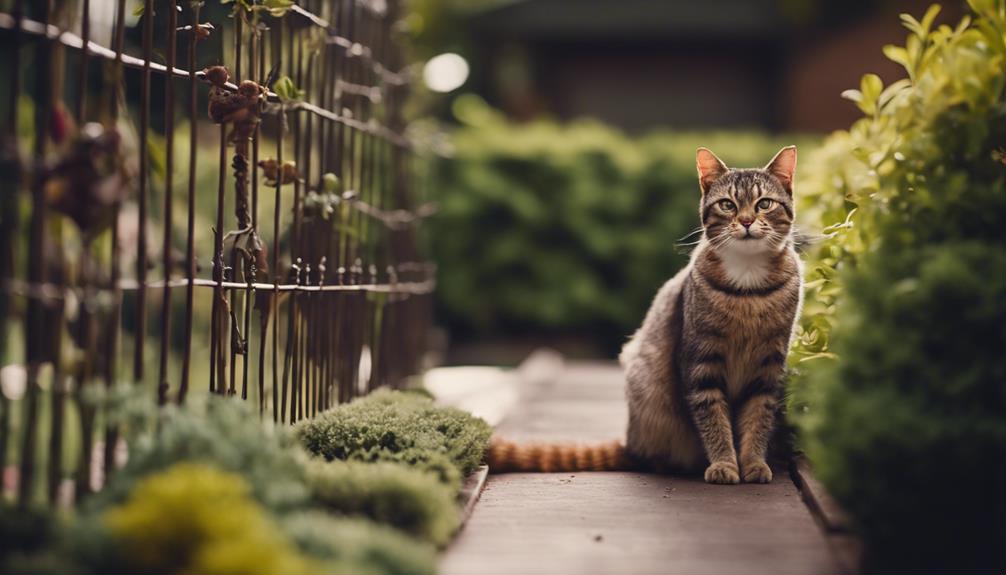
When establishing safe outdoor boundaries for cats, it's crucial to secure outdoor enclosures to prevent escapes and ensure the safety of both the cat and wildlife.
Monitoring outdoor activities can help cat owners track their pet's behavior and intervene if necessary to prevent potential wildlife interactions.
Secure Outdoor Enclosures
For enhanced safety and peace of mind, implementing secure outdoor enclosures is crucial when introducing cats to outdoor wildlife. It's essential to provide a controlled environment that allows cats to enjoy outdoor playtime while ensuring their safety and the protection of local wildlife.
Here are some key considerations for secure outdoor enclosures:
- Fencing: Install sturdy fencing around the enclosure to prevent cats from escaping and wildlife from entering.
- Netting: Use durable netting on top of the enclosure to prevent cats from climbing out.
- Shelter: Include a shelter within the enclosure for cats to seek refuge from the elements.
- Interactive Features: Incorporate toys, climbing structures, and perches to keep cats engaged and entertained.
- Escape Routes: Ensure there are no gaps or openings that could allow cats to escape or wildlife to enter.
Monitor Outdoor Activities
Implementing safe outdoor boundaries is essential for monitoring cat activities and ensuring their well-being in outdoor enclosures. By tracking behavior patterns and employing outdoor surveillance techniques, cat owners can better understand their pet's habits and interactions with the environment. Monitoring outdoor activities allows for early intervention in case of any potential risks or issues, ultimately promoting a safer outdoor experience for cats. Through the use of appropriate boundaries and surveillance methods, such as GPS trackers or motion-activated cameras, owners can keep a close eye on their cats while respecting their need for outdoor exploration. This proactive approach not only enhances the safety of the cats but also contributes to a harmonious coexistence between pets and wildlife.
| Tracking Behavior Patterns | Outdoor Surveillance Techniques |
|---|---|
| Observing regular routines | Installing motion-activated cameras |
| Noting interactions with wildlife | Using GPS trackers for location monitoring |
| Identifying any unusual behaviors | Establishing secure outdoor enclosures |
Providing Enrichment for Indoor Cats
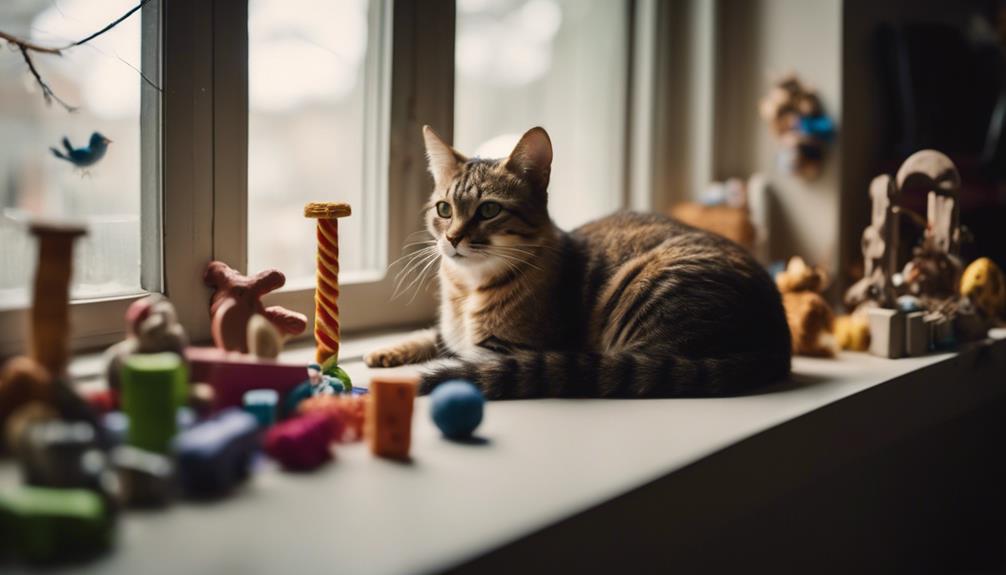
Providing enrichment for indoor cats enhances their overall well-being and mental stimulation. Indoor playtime and environmental stimulation are essential for keeping indoor cats happy and healthy. Here are some tips to help enrich your indoor cat's environment:
- Rotate Toys: Keep your indoor cat engaged by rotating their toys regularly. This helps prevent boredom and keeps them mentally stimulated.
- Create Vertical Space: Cats love to climb and perch up high. Providing cat trees or shelves can give them the vertical space they crave and create new areas for exploration.
- Interactive Feeders: Use interactive feeders or puzzle toys to make mealtime more engaging for your cat. This stimulates their natural hunting instincts and provides mental stimulation.
- Window Perches: Place a window perch near a sunny spot so your cat can watch the world outside. This helps provide environmental stimulation and entertainment.
- Hide and Seek Games: Engage your cat in hide and seek games using treats or toys. This can be a fun way to keep them active and mentally sharp.
Monitoring Your Cat's Outdoor Activities
To ensure the well-being of your indoor cat transitioning to outdoor activities, it's crucial to monitor their outdoor adventures closely. Cat tracking devices can be valuable tools in keeping tabs on your feline friend's whereabouts. These devices use GPS technology to provide real-time location updates, giving you peace of mind while your cat explores the great outdoors.
Behavior analysis is another essential aspect of monitoring your cat's outdoor activities. By observing your cat's behavior before, during, and after their outdoor adventures, you can gain valuable insights into their interactions with the environment and other animals. Look for any changes in behavior, such as increased hunting tendencies or territorial behaviors, which may indicate the need for adjustments in their outdoor routine.
Regularly reviewing the data from cat tracking devices and conducting behavior analysis can help you ensure that your cat's outdoor activities are safe and enriching. By staying vigilant and attentive to your cat's behaviors, you can help them enjoy their outdoor adventures while minimizing potential risks and ensuring their well-being.
Addressing Wildlife Interactions
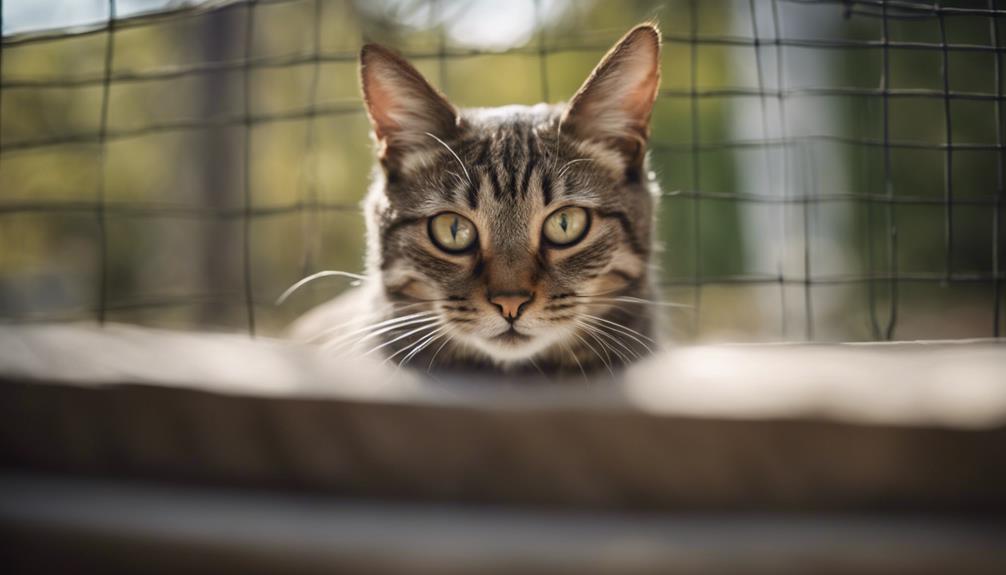
When addressing wildlife interactions, it's crucial to prioritize wildlife safety by implementing strategies to protect both local species and outdoor cats.
Cat behavior modification techniques can be employed to minimize predatory instincts and decrease potential harm to wildlife.
Enriching outdoor spaces can offer cats mental stimulation, reducing their interest in hunting wildlife.
Wildlife Safety Tips
In outdoor environments, safely coexisting with wildlife involves observing and respecting their natural behaviors. It's crucial to take safety precautions and set outdoor boundaries to protect both wildlife and pets.
Here are some wildlife safety tips:
- Avoid Feeding Wildlife: Feeding wild animals can disrupt their natural diet and behavior.
- Secure Trash Bins: Properly secure trash bins to prevent wildlife from accessing human food.
- Keep Pets Leashed: When outdoors, keep pets leashed to avoid wildlife confrontations.
- Respect Wildlife Distance: Maintain a safe distance from wildlife to prevent stress or aggression.
- Install Motion-Activated Lights: Install lights to deter wildlife from entering your property at night.
Cat Behavior Modification
Implementing effective behavior modification techniques can help address cat interactions with outdoor wildlife, ensuring the safety of both animals.
When dealing with cats that exhibit hunting behavior towards wildlife during outdoor exploration, it's crucial to employ positive reinforcement methods. Encouraging indoor play with interactive toys can redirect their natural instincts in a safe environment. Additionally, providing environmental enrichment inside the home, such as puzzle feeders or climbing structures, can help satisfy their predatory needs.
Consistent training and the use of deterrents like bells on collars can also deter hunting behavior. By modifying a cat's behavior through these techniques, owners can promote a harmonious coexistence between their pets and outdoor wildlife, ultimately fostering a safer environment for all.
Outdoor Space Enrichment
To further enhance the coexistence of cats and outdoor wildlife, owners can enrich their outdoor spaces with engaging features that cater to their pets' natural instincts. Providing opportunities for outdoor playtime and natural exploration can help satisfy a cat's curiosity and energy in a safe environment. Here are some ideas to consider:
- Interactive toys: Engage cats with toys that stimulate their hunting instincts.
- Scratching posts and trees: Offer designated areas for scratching to prevent damage to wildlife or property.
- Secure perches: Install elevated spots for cats to observe wildlife from a safe distance.
- Cat-safe plants: Introduce vegetation that's safe for cats to explore and nibble on.
- Camouflaged feeding stations: Conceal feeding areas to prevent attracting unwanted wildlife attention.
Seeking Professional Guidance and Support
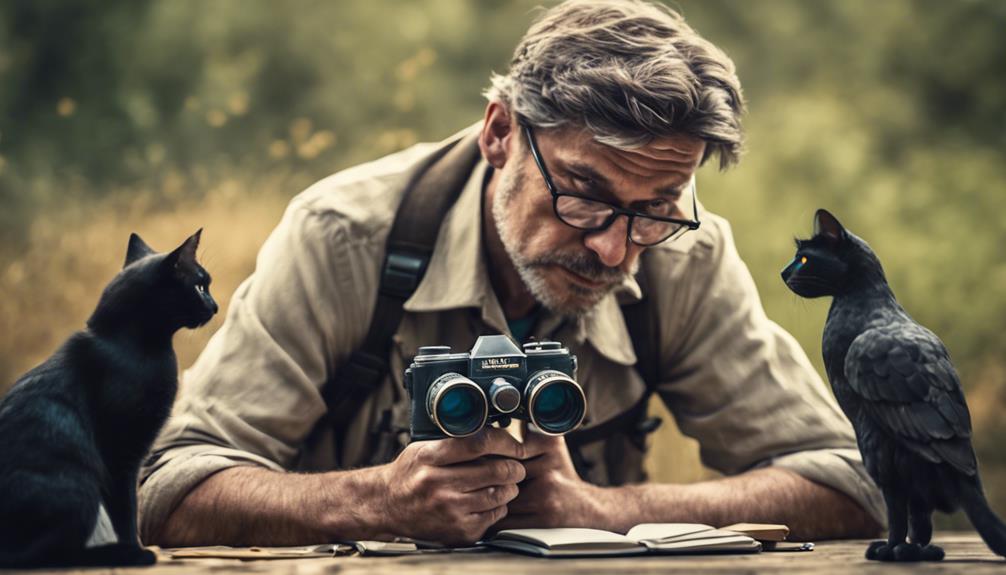
Professional guidance and support can significantly enhance the success of introducing cats to outdoor wildlife. Seeking professional counseling and expert advice when navigating the process of acclimating cats to the outdoors can provide invaluable insights and strategies to ensure a safe and harmonious transition for both the animals and the local wildlife. Professional counselors can offer tailored recommendations based on individual cat behaviors and environmental factors, helping pet owners make informed decisions that prioritize the well-being of their cats and the surrounding wildlife.
Expert advice can help cat owners understand the potential risks and benefits associated with allowing their cats outdoor access. By consulting with professionals who specialize in animal behavior and wildlife conservation, pet owners can gain a deeper understanding of how to manage cat introductions to outdoor environments responsibly. This guidance can include tips on creating safe outdoor spaces for cats, implementing enrichment activities, and monitoring their interactions with wildlife to promote a peaceful coexistence. Ultimately, seeking professional support can empower cat owners to make thoughtful choices that benefit their pets and the ecosystem.
Frequently Asked Questions
Can Outdoor Cats Be Trained to Avoid Hunting Wildlife?
Outdoor cats can be trained through behavior modification techniques to avoid hunting wildlife. This approach promotes wildlife conservation and empowers cat owners to take responsibility for their pets' impact on the environment, fostering a harmonious coexistence.
How Can I Prevent My Cat From Wandering Into Neighboring Yards or Dangerous Areas?
To keep your feline explorer from embarking on risky escapades, focus on cat containment strategies like secure fences and escape routes. Consider outdoor supervision or tracking devices for added peace of mind.
Are There Any Specific Types of Enrichment Activities That Are More Effective for Keeping Indoor Cats Stimulated and Content?
To keep indoor cats stimulated and content, provide interactive toys and window perches. This indoor enrichment can help prevent boredom and encourage exercise. Supervising outdoor time can ensure safety for both the cat and local wildlife.
How Often Should I Check on My Cat While They Are Outside to Ensure Their Safety?
When cats explore outdoors, safety precautions like monitoring techniques are vital. It's important to check on them regularly to ensure their well-being. Behavior training can help in establishing boundaries and habits for a safe outdoor experience.
What Are Some Signs That My Cat May Have Had a Negative Interaction With Wildlife That I Should Be Aware Of?
Like a vigilant scout, owners should watch for signs of a negative wildlife encounter in their cat. Changes in behavior, injuries, or unusual vocalizations may indicate such interactions. Behavior modification and tracking devices can aid in monitoring outdoor adventures.











